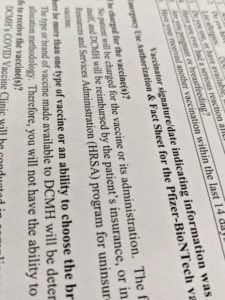
24 hour vaccine report
I was contacted yesterday early afternoon by our incident command asking if I had really meant that I was willing to participate in rollout testing for our COVID vaccine program, because if so they’d love to have me between 4:30 and 5 to get my shot.
I am prone to enthusiastic responses to vaccines, and am somewhat notorious for developing a 6 to 8 in welt on my upper arm after getting my flu shot. I did not have that response this year to the flu shot, and it was such an anomaly that half the office had come by to look, so I did give the idea some careful consideration.
I had actually planned on doing my initial vaccine next week on the 23rd of December because nothing says Christmas presents like monitoring yourself closely for vaccine reactions. I am also on-call this week, and part of the risk of getting vaccine is having a reaction, but after review of the literature available to me I felt like probably the 2nd dose is more likely to cause an issue that would actually get in the way of me doing my job (we’ll see in three weeks), and I am quite frankly a sucker for being helpful if it means making history happen.
So I got my 1st coronavirus vaccine around 5:00 yesterday afternoon.
For complete transparency, I went to the gym on Wednesday the 16th of December and did upper body reps until failure in multiple supersets. When I went in to get my vaccine last night, I was already having some low-grade muscle aches throughout my upper body.
By bedtime I had essentially no response. I had no increase in pain in my upper arm, no erythema, nope welt, nothing at all. There was in fact so much nothing that I made my husband take a picture of it so that I could really see, and – in his words – “one of the two spots in this picture is a freckle, and one of them is where the shot went in, I can’t tell which one is which.”
I woke up this morning with two sore arms. My right is the usual discomfort I expected from the gym on Wednesday (foam roll, people, it’s real) but my left arm is definitely a little more painful than the right. My deltoid has a dull ache in it every time I lift my arm. It’s not enough to stop me but it’s a reminder. I took some naproxen, because that is my analgesic of choice.
That ache has continued through most of the day so far; this morning it was a gentle reminder every time I use that arm, but this afternoon (without any more naproxen), my arms feel pretty much the same. I still have no significant redness, no swelling, and no actual tenderness at the site. Currently, rating this somewhere between the flu vaccine and the Tdap (which hurts).
Questions I don’t have answers for about this vaccine:
Does this protect me from giving COVID to others?
I don’t know for sure. When scientists design an experiment, they determine what they are testing and how they are testing it in advance. Sometimes it is possible to use the data from an experiment to draw other conclusions, but we always have to be careful when using an experiment to answer questions it wasn’t designed to ask.
We know from the remarkable data gathered by the Fairbanks School of Public Health and the Indiana Department of Health early in the pandemic that something like 40% of people who were positive for coronavirus DNA were asymptomatic or pre-symptomatic. These patients can only be detected through surveillance testing ( either testing everyone in a certain set of people or testing known contacts of ill persons) or by testing them when they develop symptoms later, and are known to be transmitters of the virus.
The vaccine trials that were done and are still ongoing were not designed to test for asymptomatic coronavirus infections. Testing for COVID-19 through the trial protocols was only done on symptomatic individuals – people who were sick in some way. Because Pfizer didn’t test everyone on a regular basis regardless of symptoms, we don’t actually know what the prevalence of asymptomatic infections was in this study.
That means I’m still wearing my mask to protect you — and perhaps now it’s even more important for me to do so.
How long does the vaccine protect me for?
I don’t know. We just don’t have the long term data on efficacy yet. We can hope that immunity will be measured in years (although a seasonal vaccine, like the flu shot, is still very much a possibility). We can also hope that enough people get the vaccine and have enough immunity to mitigate the seriousness of infections, reducing the health care system overload and giving us time to develop effective treatments for this disease.